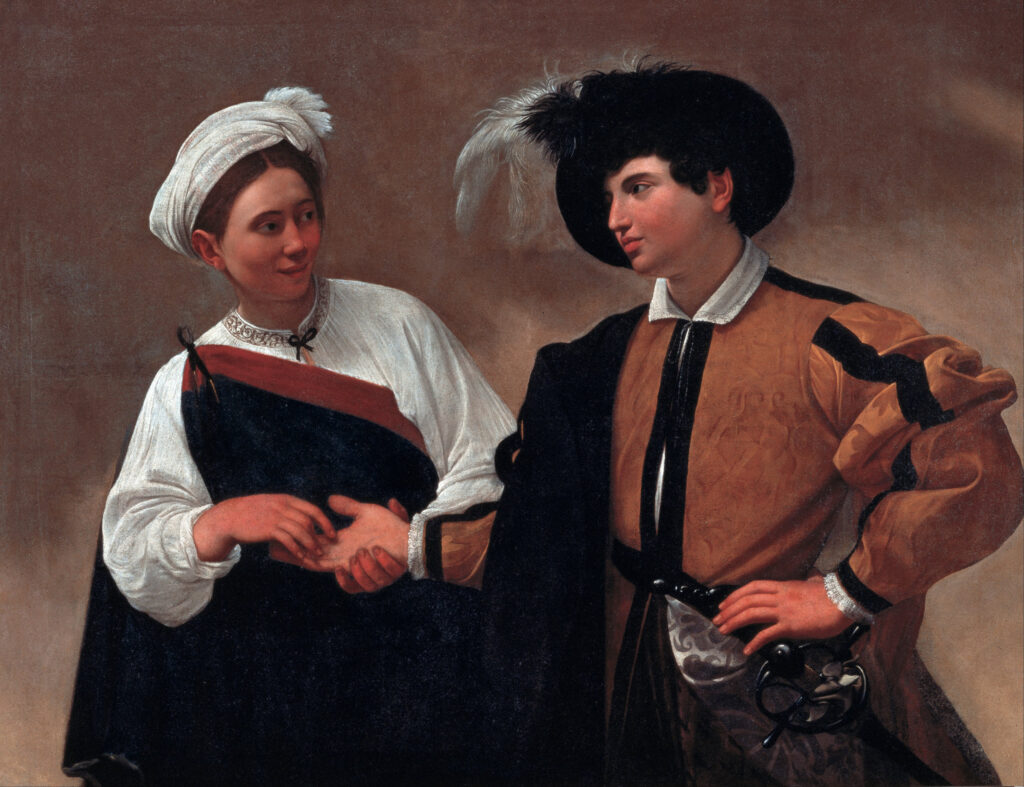In the early 17th century a notable court case unfolded in Romes courtroom involving the rival Baroque artists Caravaggio and Baglione. Caravaggio, known for his mastery of light and shadow and Baglione celebrated for his focus, on forms and elegance engaged in a competition for respect and recognition in their artistic works. Their rivalry extended beyond art when Baglione publicly sued Caravaggio over poems written by him. In the midst of the battle, Caravaggio boldly stated that he didn’t consider Giovanni Baglione to be a painter—a statement that significantly damaged Bagliones reputation and perception among art enthusiasts.
In retaliation to these accusations Baglione created “Divine Love Overcoming Earthly Love ” a painting illustrating a figure representing Divine Love triumphing over figures symbolizing earthly love. The artwork portrays Divine Love in a stance symbolizing purity prevailing over earthly desires while the representation of earthly love lies defeated.
To delve deeper into this rivalry we will analyze how both artists depicted the scene to either validate Caravaggios remarks or justify the significance, behind Bagliones artwork. Caravaggios painting “Judith Beheading Holofernes” and Giovanni Bagliones artwork “Judith and the Head of Holofernes” both tell the tale of Judith, from artistic perspectives evoking varying emotional reactions.
In Caravaggios piece “Judith Beheading Holofernes ” the dramatic scene depicts Judith, a widow beheading the general Holofernes to free her people. Caravaggios use of light and shadow contrasts intensifies the moment showing Judith in action with her Abra as they carry out the act. The painting captures the brutality as Holoferness face reveals pain and anguish while Judith shows a mix of emotions amid executing the deed.
On the other hand Baglione’s rendition in “Judith with the head of Holofernes” portrays a composed Judith holding Holofernes severed head symbolizing her triumph over his oppression. This depiction showcases Judith with grace and nobility dressed elegantly to underscore her virtue. The painting highlights her nature portraying her not as a rescuer but also as an embodiment of moral strength through her mature reaction, to the event.
Caravaggio was well known for his lifelike. Harsh portrayals of biblical scenes, which occasionally sparked disputes especially with Church authorities. His artwork vividly depicts the brutality of the scene diverging from the Churchs preference, for narratives. Of the opulent clothing seen in other depictions Caravaggio chose a Renaissance style dress for Judith challenging traditional gender norms and presenting her as a strong presence in a male dominated world. This painting showcases Caravaggios style of portraying figures with emotional and physical realism focusing on their human struggles rather than their sacred representations. This often led to conflicts with Church officials who preferred idealized depictions emphasizing divine justice. The bold brushstrokes used by Caravaggio heighten the intensity of the scene through the portrayal of blood enhancing the paintings dramatic impact.
On the hand Baglione’s work aligns closely with the Church’s expectations for religious art during the Baroque era. His portrayal of Judith is more dignified and less confrontational. The calm and composed manner in which Judith is depicted holding Holofernes severed head implies a focus on justice and Judith’s role as an instrument of God’s will than, on the violent act itself.
Bagliones depiction aligns nicely, with the principles of the Counter-Reformation aiming to convey stories as educational messages for the observer. This method was particularly acknowledged by the Church as it aimed to utilize art, for guidance and spiritual involvement.
This conversation leads us to ponder whether Caravaggio’s critiques were justified or if Giovanni Bagliones artwork “Divine Love Overcoming Earthly Love” presents a evaluation. While I think Caravaggios comments are somewhat harsh it’s hard to ignore Bagliones skill, in painting and his expertise in Baroque art. His use of lighting, meticulous attention to detail and dynamic compositions imbue his pieces with spiritual depth often sought after by religious organizations. As a result, Baglione’s creations could be seen as a critique of Caravaggio, who some believe might lack biblical integrity.
Nevertheless, I must also advocate for Caravaggio’s method due to its connection with humanity allowing viewers to delve deeper into themes. Caravaggio is renowned for the intricacy in his artworks capturing moments of feelings and moral dilemmas that resonate on visual, emotional, and intellectual levels. This human-centered approach aligns well with the Bible’s goal of fostering relatability. Recognized as a figure in art history Caravaggio has made contributions to the Baroque style, especially through his mastery of chiaroscuro. This technique highlights the contrast, between shadows and bright light sources adding depth to his subjects and distinguishing him from peers who idealized their figures.
Both artists deserve recognition, for their impact, on art as they have brought viewpoints and skills that influence how religious and human themes are portrayed in their creations. We will explore their work through today’s exhibition.
PLEASE PRESS PLAY BEFORE ENTERING
“Divine Love Conquering Earthly Love” by Giovanni Baglione 1602
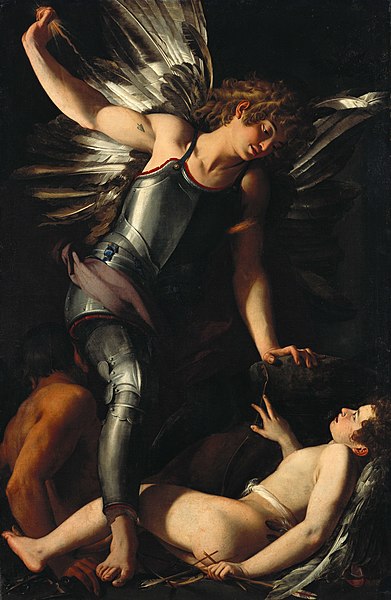
Giovanni Bagliones painting "Divine Love Conquering Earthly Love" depicts a captivating clash between two aspects of love. The artwork portrays the Eros, symbolizing love overpowering the earthly Eros representing carnal passions. The positioning of the Eros above his counterpart underscores his moral and physical superiority in the composition. With an dignified demeanor the divine Eros exudes a sense of purity visually emphasized by a glow surrounding him that hints at his celestial essence. In contrast the defeated earthly Eros appears human and vulnerable depicted with wings that accentuate his loss. The simplistic background directs focus on the interaction, between these two characters emphasizing not the central theme of spiritual love prevailing over physical desires but also heightening the emotional intensity of this dramatic confrontation.
“Judith Beheading Holofernes” by Caravaggio 1598
In Caravaggios painting "Judith Beheading Holofernes " we see a depiction of Judith, a Jewish figure carrying out the beheading of Holofernes, the Assyrian general to protect her people. The artwork zooms in on this moment showcasing Judiths grip, on Holoferness hair as she uses a sword to cut his neck. Holofernes is shown in pain his face contorted with suffering as he lies on his bed highlighting the brutality of the scene. Blood spurts from his neck realistically adding a detail to the painting. Judith displays determination while Holofernes exhibits shock and agony. Standing next to Judith is a maid who adds solemnity and serves as a witness, to the event. The dark background creates an atmosphere that intensifies the impact of this violent and crucial event.

“Judith with the head of Holofernes” by Giovanni Baglione 1566 – 1643
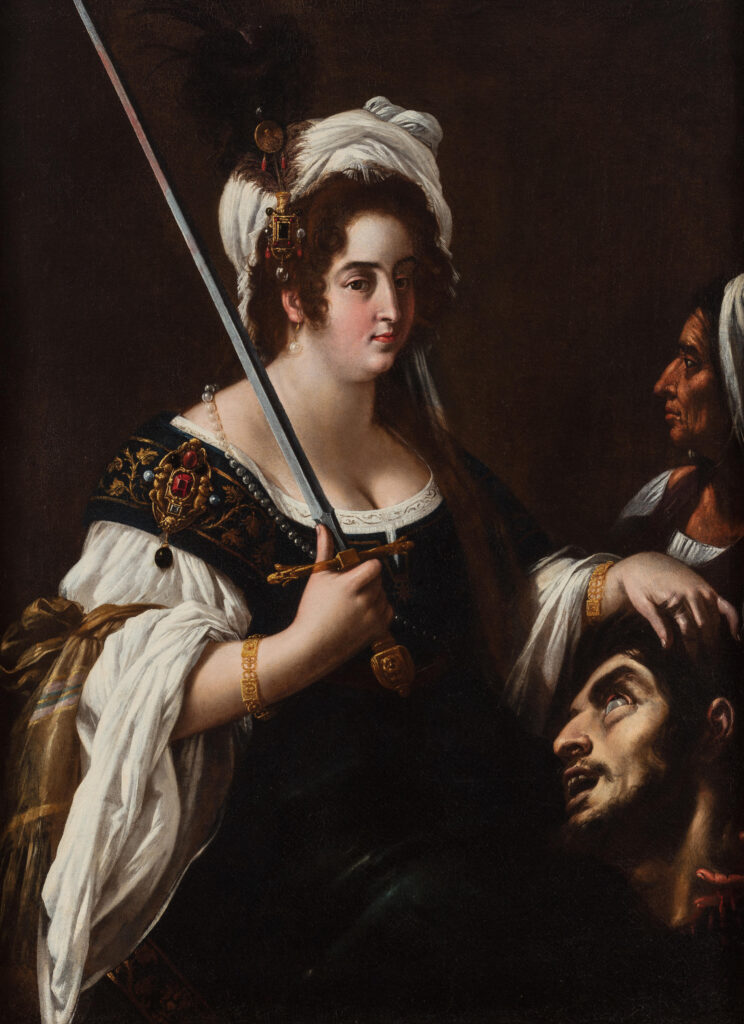
Giovanni Bagliones artwork titled "Judith with the head of Holofernes" captures a moment of peace intertwined with strength after a gripping tale. In this portrayal Judith is shown holding the head of Holofernes symbolizing her victory over the leader. Unlike renditions that often depict action Bagliones Judith exudes serenity and poise embodying the grace and righteousness of her actions. The painting positions Judith at the center showcasing her as both a savior and a dispenser of justice. Than exuding triumph her expression conveys contemplation and fulfillment of duty steering away from vengeance. The color palette is muted, with gentle lighting accentuating her face and the head she holds high drawing viewers focus, to these elements. The background remains simple. Understated to ensure that Judiths figure and her deed take center stage in the artwork. This depiction not highlights Judiths courage and moral steadfastness. Also adds a somber tone to the story.
“The Conversion of Saint Paul” by Caravaggio 1600
Caravaggios painting "The Conversion of St. Paul " also referred to as "The Conversion, on the Way to Damascus " captures the instance when Saul, a persecutor of Christians is struck blind and embraces Christianity while traveling to Damascus. The artwork focuses on Sauls ( named Paul) transformation highlighting both his spiritual collapse with great detail. The composition stands out for its yet depiction and emotional depth. Saul is shown lying down bathed in a light symbolizing the presence of God although no explicit heavenly figure is portrayed. His outstretched arms reveal shock and surrender while his horse stands peacefully by his side creating a contrast in the scene. The dark background and the focused light, on Saul emphasize his vulnerability and the profound significance of his experience. This artistic approach draws viewers attention to Sauls emotions and stance effectively conveying the journey of his conversion. Caravaggios portrayal is personal and relatable inviting observers to immerse themselves in this moment of intervention.
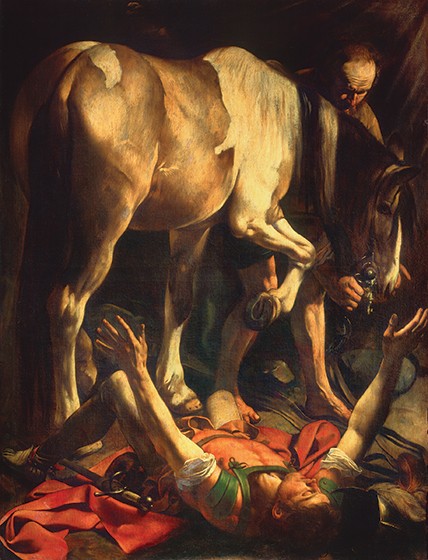
“ The Ecstasy of Saint Francis” by Giovanni Bagliones 1601
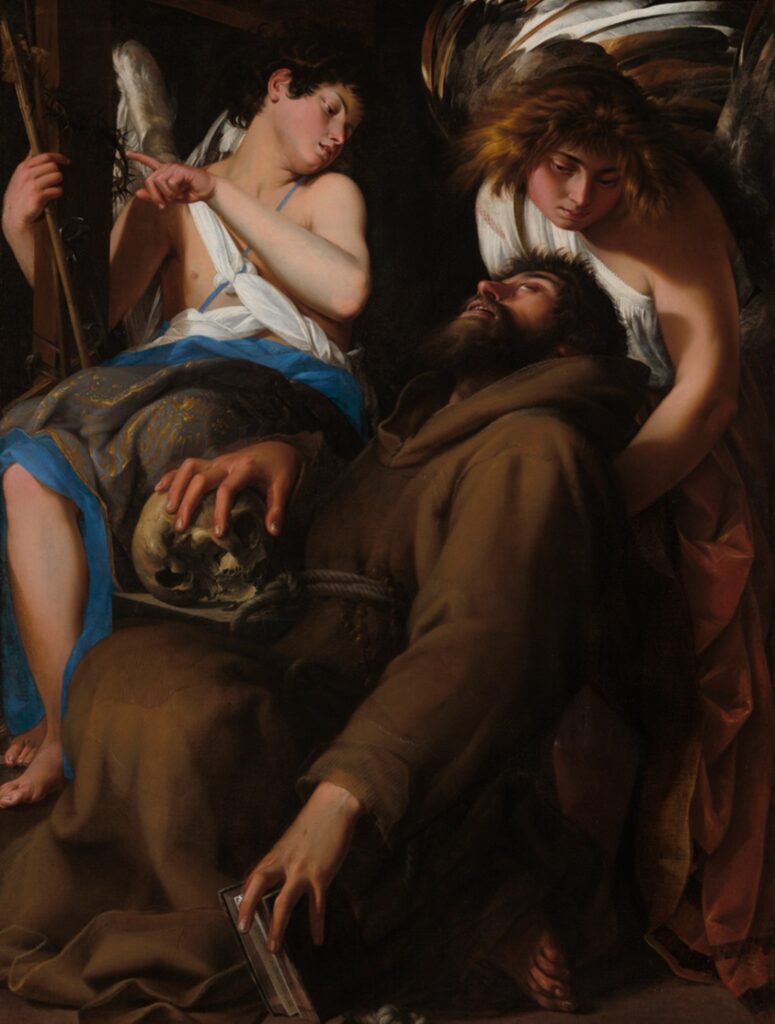
Giovanni Bagliones painting "Saint Francis of Assisi in Ecstasy" beautifully captures a moment in the life of Saint Francis of Assisi showcasing his union with the divine. The artwork portrays Saint Francis experiencing a connection, depicted with eyes and a worship posture as he receives the wounds of Christ, known as the stigmata.The painting centers, on Saint Francis placed prominently amidst lighting that intensifies the impact of the scene and accentuates his expression of blissfullness. His outstretched hands reveal the stigmata emphasizing the nature of this event.The tranquil and natural surroundings in the painting reflect Saint Franciss connection with nature an aspect of his spiritual journey. By keeping the setting simple and focusing on Saint Francis, Baglione underscores the significance of his encounter, as the focus of the artwork. Through this approach Baglione delves into themes of revelation and its profound transformative influence, symbolized by Saint Franciss physical and spiritual ecstasy.
“ The Cardsharps” by Caravaggio 1590–1594
Caravaggios painting "The Cardsharps" portrays a scene of trickery and mystery unfolding during a card game. The artwork skillfully captures the cunning of youth and the vulnerability, to deception depicted with Caravaggio’s signature style and focus on depth. The painting revolves around three characters; a naive young player engrossed in his cards, an experienced cardsharp covertly signaling to an accomplice and the accomplice sneakily peeking at the players hand to assist the cardsharp. Set against a backdrop the attention is drawn to the dynamics and expressions of these figures. Caravaggio employs lighting to highlight the faces and hands of the players intensifying the tension and drama of deceit within the scene. The innocent expression of the player starkly contrasts with the glances of those cheating telling a story about trust and treachery. This artwork not demonstrates Caravaggio’s talent in capturing emotions and relationships but also reflects on ethical and societal concerns prevalent, during his era.
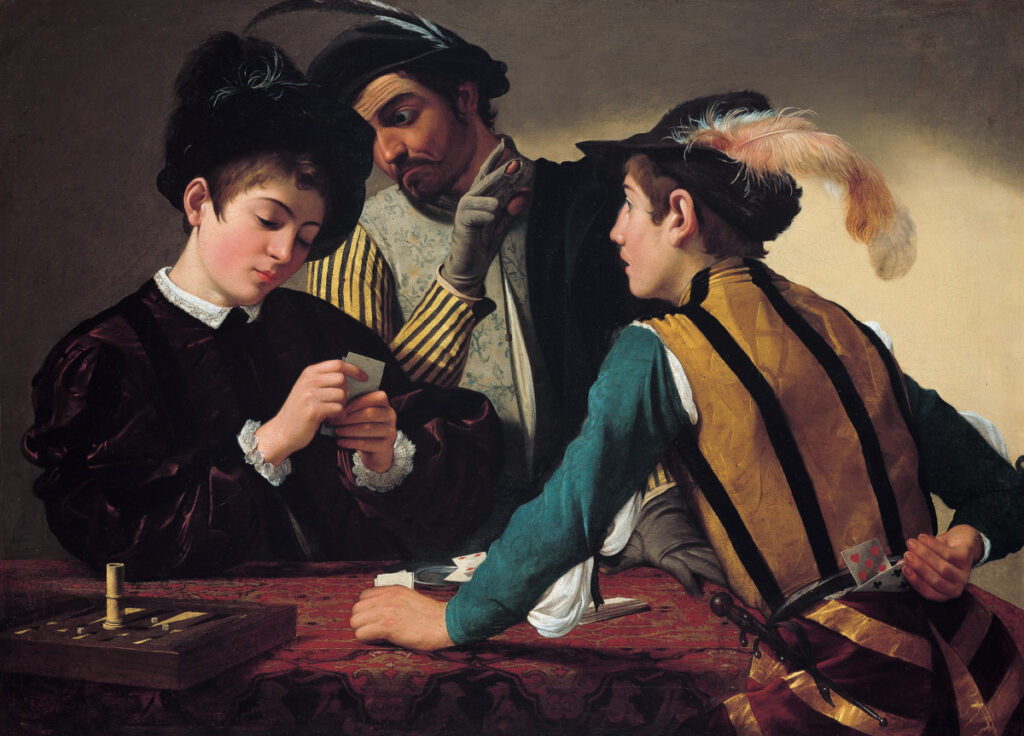
“Saint John the Baptist” by Giovanni Bagliones 1610
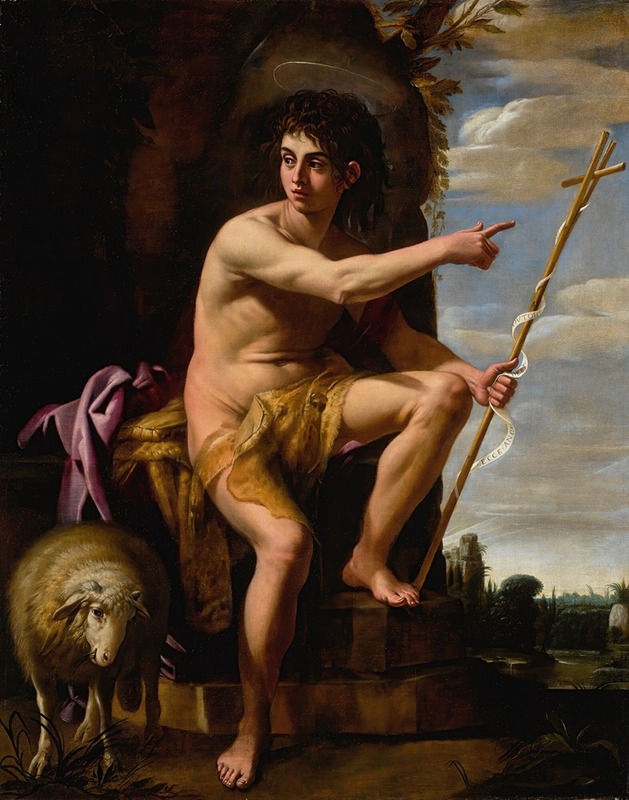
Giovanni Bagliones painting "Saint John the Baptist, in the Wilderness" showcases the character of John the Baptist during his time in the wilderness focusing on contemplation and asceticism. The artwork portrays Saint John as a figure amidst a landscape emphasizing his solitude and spiritual dedication. The painting centers on Saint John, who appears in thought with a gesture pointing symbolizing his role as Christs forerunner and his divine calling. He is shown wearing attire such as an animal skin garment and holding a reed cross underscoring his identity as a prophet leading a life of penance and simplicity. The gentle natural light illuminates Saint Johns face and clothing texture emphasizing his physical state. The overall mood conveys solemnity and respect capturing John the Baptists commitment to his journey in the wilderness. Baglione’s depiction not honors the importance of the figure but also reflects humanitys enduring struggle, with faith and purpose.
“The Fortune Teller” by Caravaggios 1594
Caravaggios painting "The Fortune Teller" portrays a captivating street scene where a off young man consults with a girl, about his fortune. The artwork is praised for its representation of occurrences and Caravaggios adept use of realism and emotion to capture human interactions. The focal points of the composition are the attired man and the fortune teller who engages him with intense focus while slyly removing a ring from his finger symbolizing themes of trust and deceit. Against a backdrop the viewers attention is drawn solely to their exchange. Caravaggio employs lighting to emphasize their expressions and movements enriching the story of craftiness and innocence. "The Fortune Teller" reveals Caravaggios talent in portraying connections and societal critiques establishing it as an important piece in terms of both artistic skill and subject matter. It offers a glimpse into the complexities of street life blending elements of playfulness, with deception frozen in a moment.
